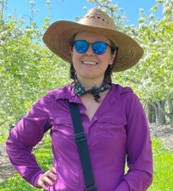Written by Katlyn Catron, WSU TFREC, June 1 2023
Earwigs get a lot of flak from humans – their name conjures unpleasant mental images, they’re creepy and crawly as they move, and their cerci (or “pinchers,” though they rarely pinch) look way more aggressive than any body part used for mating ought to. Some growers have good reason to dislike them, as earwigs can cause damage to soft fruits like peaches. However, for folks who grow firmer fruits like apples and pears, earwigs are actually incredibly useful allies in the fight against woolly apple aphid and pear psylla. Earwigs are so effective at wiping out colonies of soft-bodied pests in these systems that the Washington State University Tree Fruit Research and Extension Center is distributing thousands of earwigs to growers who want to utilize them as a method of natural pest control. Join us in Wenatchee on July 12 to receive your earwig battalion, and read on to learn more about why, despite their flaws, earwigs are fantastic additions to pome fruit pest management programs.


“Earwigs have a unique role on a team of natural enemies,” says Dr. Robert Orpet, assistant professor at WSU TFREC and research lead of the Pear Insects Lab. Orpet has studied earwigs in tree fruit systems for over six years, and has identified the key aspects of earwig biology that make them so useful to pear and apple growers. Because of their nocturnal nature, growers may not see earwigs actively preying on pest bugs like they do other natural enemies. However, Orpet has evidence that earwigs can truly decimate soft-bodied pests like woolly apple aphids and pear psylla. In a short YouTube video aptly titled “Earwig eliminates woolly apple aphid colony”, he shows night vision footage of a single immature earwig meticulously picking away at the cotton ball fluff of gathered aphids, leaving the branch clean by sunrise (screen captures are shown in Figures 1 and 2). The individual actions of earwigs and other natural enemies as part of integrated pest management plans add up to orchard-wide decreases in both pest insect populations and overall spray costs.
During the day, earwigs huddle together under tree bark or in other dark, humid, tight spaces. While this aggregation strategy can make for an unpleasant encounter with a human moving cardboard around in a shed or basement, it also makes collecting and relocating earwigs incredibly easy. Using rolls of corrugated cardboard tied to tree trunks as traps, researchers have shown that thousands of earwigs can be collected from an undesired location like a peach orchard, and moved to an area where their predatory instincts can be put to good use. It is via this easy trap and transport method that the Pear Insects Lab will collect earwigs from Floyd and Betsy Stutzman’s peaches, where they are not wanted, and distribute them to pome fruit growers on July 12.
Once relocated, earwigs tend to stay put. “Unlike lady beetles, which have multiple generations per year and are in and out of orchards,” Orpet says, “earwigs are a relatively constant presence with just one generation per year.” Earwigs born in or relocated to an orchard are likely to stay there, reproduce, and continue to feed on soft-bodied insects if conditions are favorable. Earwigs are very vulnerable to broad-spectrum chemistries, which means that pome fruit growers who want earwig help must prioritize selective chemistries and appropriate spray timings. “[Earwigs] can easily be lost when sprays are incompatible,” cautions Orpet. The “dream orchard” for a population of earwigs is one transitioning away from conventional chemical management and towards a more integrated pest management approach. That way, the deployed earwigs aren’t redundant with others already present in the orchard, they’re not going to be killed off by sprays, and there’s plenty of food to go around.
We hope that, because of this article, the lowly earwig has gained a little more clout as an ally, at least in pear and apple pest management. If you are a pome fruit grower and are interested in learning more about earwig relocation, deployment, or biocontrol, please join us at the WSU TFREC on July 12 for more fun facts, swag, and your own battalion of biocontrol earwigs! Email Katlyn Catron for more information or to RSVP.
References
Beers, EH, NJ Mills, PW Shearer, DR Horton, ER Milickzy, KG Amarasekare, LM Gontijo. 2016. Nontarget effects of orchard pesticides on natural enemies: Lessons from the field and laboratory. Biological Control 102: 44–52.
Höhn, H, A Lahusen, R Eder, T Ackermann, L Franck, HU Höpli, J Samietz. 2007. Régulation du psylle du poirier Résultats et observations de 2002 à 2006 en Suisse alémanique. Revue suisse Vitic Arboric Hortic 39: 169–176.
Orpet, RJ, JR Goldberger, DW Crowder, VP Jones. 2019. Field evidence and grower perceptions on the roles of an omnivore, European earwig, in apple orchards. Biological Control 132: 189–198.
Orpet, RJ, DW Crowder, VP Jones. 2019. Biology and Management of European Earwig in Orchards and Vineyards. Journal of Integrated Pest Management 10:
Contact
Katlyn A. Catron
Pest Biologist, WSU TFREC
katlyn.catron@wsu.edu
Funding and Acknowledgements
This work is funded in part by Western SARE Project #WRGR23-004
Fruit Matters articles may only be republished with prior author permission © Washington State University. Reprint articles with permission must include: Originally published by Washington State Tree Fruit Extension Fruit Matters at treefruit.wsu.edu and a link to the original article.

